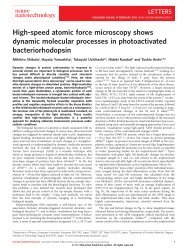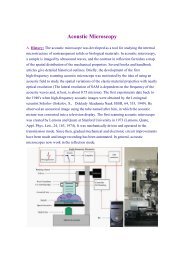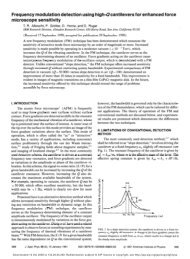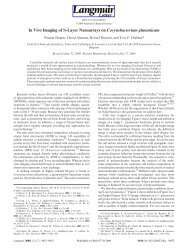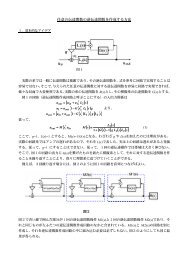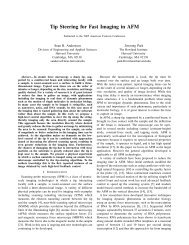Single Molecular Imaging of a micro-Brownian Motion and a Bond ...
Single Molecular Imaging of a micro-Brownian Motion and a Bond ...
Single Molecular Imaging of a micro-Brownian Motion and a Bond ...
You also want an ePaper? Increase the reach of your titles
YUMPU automatically turns print PDFs into web optimized ePapers that Google loves.
1<br />
<strong>Single</strong> <strong>Molecular</strong> <strong>Imaging</strong> <strong>of</strong> a <strong>micro</strong>-<strong>Brownian</strong> <strong>Motion</strong> <strong>and</strong> a <strong>Bond</strong> Scission <strong>of</strong> a<br />
Supramolecular Chiral π-Conjugated Polymer as a <strong>Molecular</strong> Bearing<br />
Driven by Thermal Fluctuations<br />
Ken-ichi Shinohara,* 1,3 Noriyuki Kodera, 2 <strong>and</strong> Toshio Ando 2,3<br />
1 School <strong>of</strong> Materials Science, Japan Advanced Institute <strong>of</strong> Science <strong>and</strong> Technology (JAIST), 1-1 Asahi-dai, Nomi, Ishikawa 923-1292<br />
2 Graduate School <strong>of</strong> Natural Science <strong>and</strong> Technology, Kanazawa University, Kanazawa, Ishikawa 920-1192<br />
3 SENTAN, Japan Science <strong>and</strong> Technology Cooperation (JST)<br />
The <strong>micro</strong>-<strong>Brownian</strong> motion <strong>of</strong> a single polymer chain<br />
was directly measured by high-speed (rapid-scan) AFM on a<br />
mica substrate under an aqueous solution at room temperature.<br />
The diffusion constant was 1.3 x 10 -14 m 2 /s, which is a basic<br />
property <strong>of</strong> a molecular bearing at a solid-liquid interface. The<br />
molecule was a <strong>micro</strong>meter-long supramolecular chain in<br />
which π-conjugated polyrotaxane was coupled by a π-π<br />
interaction. <strong>Bond</strong> scission <strong>of</strong> this supramolecular chain was<br />
directly observed, <strong>and</strong> the dynamic folding behavior <strong>of</strong> a<br />
single polymer chain was also imaged.<br />
(Received August 31, 2007; CL-070940; E-mail: shinoken@jaist.ac.jp)<br />
Polymers are very useful materials that display many<br />
excellent properties, <strong>and</strong> have become indispensable in<br />
maintaining <strong>and</strong> developing our current way <strong>of</strong> life.<br />
Especially, π-conjugated polymers are recognized as part <strong>of</strong><br />
the next-generation <strong>of</strong> functional polymers for photonic <strong>and</strong><br />
electronic applications. 1-3 Nevertheless, it is difficult to<br />
discuss the correlation between their structures <strong>and</strong> properties<br />
at the molecular level because polymers are diverse, dynamic,<br />
<strong>and</strong> can be very complex. If the structure <strong>and</strong> properties <strong>of</strong> a<br />
polymer could be directly observed, then with minimal<br />
inferences or hypotheses, the relationship between polymer<br />
structures <strong>and</strong> functions could be clarified. Consequently,<br />
molecular devices <strong>of</strong> a polymer might be created based on<br />
new design concepts <strong>and</strong> new working principles, which may<br />
lead to s<strong>of</strong>t nano-machines. Recently, we have directly<br />
observed single molecules in a π-conjugated polymer at room<br />
temperature using a scanning tunneling <strong>micro</strong>scope (STM) 4<br />
<strong>and</strong> an atomic force <strong>micro</strong>scope (AFM) 5 to measure a chiral<br />
helical structure, <strong>and</strong> a total internal reflection fluorescence<br />
<strong>micro</strong>scope (TIRFM) to image single molecular dynamic<br />
fluorescence. 6,7<br />
π-Conjugated polymers may be flexible because they are<br />
organic molecules. We have used high-speed (rapid-scan)<br />
AFM 8 to observe their flexibility <strong>and</strong> motion driven by<br />
thermal fluctuations. The observed polymer is the same as<br />
those in previous research where the molecular structure <strong>and</strong><br />
functions were simultaneously observed using a combination<br />
<strong>of</strong> an AFM <strong>and</strong> an objective-type TIRFM. 9 Figures 1a <strong>and</strong> 1b<br />
show the chemical structure <strong>and</strong> optimized molecular model,<br />
respectively. This π-conjugated polymer has a molecular<br />
bearing structure, which is a kind <strong>of</strong> s<strong>of</strong>t nano-machines.<br />
Figure 1c shows the flexible motion <strong>of</strong> a single chain <strong>of</strong> the<br />
supramolecular π-conjugated polymer on mica under an<br />
aqueous solution at room temperature. Because its height,<br />
which is ca. 1.5 nm, corresponds to the height <strong>of</strong> α-<br />
cyclodextrin, the polymer chain is clearly a single molecule as<br />
Figure 1. (a) Chemical structure <strong>of</strong> a polyrotaxane: (+)-poly[AEPErotaxa-(α-CyD)].<br />
(b) A molecular mechanics calculation optimized<br />
model <strong>of</strong> a supramolecular polymer. (c) High-Speed AFM images <strong>of</strong><br />
a single molecule <strong>of</strong> a supramolecular chiral π-conjugated polymer on<br />
mica under aqueous solution at room temperature. (8.48 s–14.08 s)<br />
UV pulsed laser <strong>of</strong> 355 nm irradiating 20 nJ at 20 Hz. (13.92 s–14.08<br />
s) The dynamic folding behavior <strong>of</strong> the cut end in a single polymer<br />
chain. (8.64 s) The imaging <strong>of</strong> chain scission in a single molecule.<br />
The point <strong>of</strong> a scission is indicated by a red arrow. XY-range: 400<br />
nm x 400 nm. Z-range: 5.0 nm. Scan rate: 160 ms per frame. Pixel:<br />
100 x 100. Dynamic images <strong>of</strong> single molecular (+)-poly[AEPErotaxa-(α-CyD)]<br />
as a Supporting Information. 10 (d) A cross sectional<br />
result <strong>of</strong> single polymer chain on the red line indicated in a high-speed<br />
AFM image at 0 s as shown in Figure 1c.<br />
shown in Figure 1d. Various studies have been trying to<br />
apply rigid rod-like π-conjugated polymers to a molecular<br />
wire for molecular electronics devices, but it is troublesome if<br />
the wire moves. While conducting an experiment, we<br />
envisioned a new design concept for a molecular device that<br />
has the flexibility <strong>of</strong> a single molecule. We collected images<br />
for a total <strong>of</strong> 14.08 s, <strong>and</strong> irradiated with an ultraviolet (UV)<br />
pulsed laser during the last 5.6 s as shown in Figure 1c.<br />
During the pulsed laser irradiation, the cantilever was bent<br />
due to the light pressure <strong>of</strong> the laser beam. Thus, the probe
2<br />
Figure 2. (a) Analytical results <strong>of</strong> the displacement in a single polymer chain <strong>of</strong> (+)-poly[AEPE-rotaxa-(α-CyD)] at scanning rates <strong>of</strong> 80, 120, 150, 181.8,<br />
200, 250 <strong>and</strong> 300 ms per frame in high-speed AFM imaging (without UV pulsed laser irradiation). Lines are the best fits <strong>of</strong> the data to a gaussian curve; the<br />
st<strong>and</strong>ard deviations are 5.81, 6.40, 5.76, 7.43, 6.49, 7.76, <strong>and</strong> 8.99 nm, respectively. (b) Mean-square displacement as a function <strong>of</strong> time <strong>of</strong> tip-scanning<br />
cycle in the direction <strong>of</strong> the X-axis. The mean-square displacements were obtained from the st<strong>and</strong>ard deviations in Figure 2a. The plots were fitted to<br />
equation, = 2Dt. A diffusion constant <strong>of</strong> a <strong>micro</strong>-<strong>Brownian</strong> motion is 1.3 x 10 -14 m 2 /s.<br />
pressed the observation surface for an instant. The scanning<br />
line, which looks like a scratch, showed this state from 8.48 s<br />
to 14.08 s. Hence, we observed the probe pressing onto a<br />
single polymer chain with a high probe tip pressure while<br />
irradiating, which subsequently cut the single polymer<br />
molecule as shown in the image at 8.64 s. We also observed a<br />
folding phenomenon, i.e., the cut end folded dynamically<br />
(from 13.92 s to 14.08 s). The fact that the probe tip pressure<br />
cut the polymer chain supports our conclusion that the<br />
polymer is a supramolecular polymer coupled by molecular<br />
interaction because molecular interaction force is weaker than<br />
a covalent bond. Thus, information in terms <strong>of</strong> structural<br />
chemistry can be obtained. Figure 1c shows the images under<br />
an aqueous solution at room temperature. We consider that<br />
this is a <strong>micro</strong>-<strong>Brownian</strong> motion, which is excited by the<br />
<strong>Brownian</strong> motion <strong>of</strong> water molecules at room temperature.<br />
Unlike STM, AFM uses the AC (tapping) mode <strong>and</strong> the probe<br />
touches the surface. It is speculated that molecules move<br />
mainly due to the touching probe tip, although there may also<br />
be <strong>Brownian</strong> motion. Hence, we conducted a detailed<br />
analysis. We changed the probe scanning speed, <strong>and</strong> analyzed<br />
the one-dimensional displacement <strong>of</strong> a single polymer<br />
molecule in the probe scanning direction. In practice, we<br />
changed the frame rate to 80, 120, 150, 181.8, 200, 250, <strong>and</strong><br />
300 ms per frame, <strong>and</strong> collected images under the seven<br />
different conditions, <strong>and</strong> analyzed the displacement. We<br />
made a histogram <strong>of</strong> these analysis results with the<br />
displacement as the horizontal axis <strong>and</strong> the observation<br />
number as the vertical axis, <strong>and</strong> fitted the data to the Gaussian<br />
curve as shown in Figure 2a. Finally, we plotted the square <strong>of</strong><br />
the st<strong>and</strong>ard deviation <strong>of</strong> this distribution (i.e., mean-square<br />
displacement, ) <strong>and</strong> the probe scanning cycle time (t) as<br />
shown in Figure 2b. The result shows that the mean-square<br />
displacement in a single supramolecular polymer chain is<br />
proportional to the time <strong>and</strong>, hence, complies with Einstein’s<br />
Law <strong>of</strong> <strong>Brownian</strong> motion.<br />
= 2Dt<br />
Here, D is the diffusion coefficient. In this result, the D<br />
value is calculated as 1.3 x 10 -14 m 2 /s in the one-dimensional<br />
motion. Hence, this motion is a <strong>Brownian</strong> motion at solidliquid<br />
interface, <strong>and</strong> the motion in a single polymer chain is a<br />
<strong>micro</strong>-<strong>Brownian</strong> motion, i.e., thermal motion.<br />
We anticipate that our studies will be the basis for<br />
creating innovative molecular devices such as molecular<br />
motors or molecular electronics/photonics materials, which<br />
utilize thermal stochastic energy as the driving source.<br />
This research was financially supported by the Grant-in-Aids for<br />
Scientific Research for Young Scientists (A) from the Ministry <strong>of</strong> the<br />
Education, Culture, Sports, Science <strong>and</strong> Technology (MEXT), Japan (No.<br />
15685007) (to K. S.).<br />
References <strong>and</strong> Notes<br />
1 R. E. Martin, F. Diederich, Angew. Chem. Int. Ed. Engl. 1999, 38,<br />
1350.<br />
2 H. Meier, Angew. Chem. Int. Ed. Engl. 1992, 31, 1399.<br />
3 H. Bleier, Organic Materials for Photonics, Elsevier, Amsterdam,<br />
1993, 77.<br />
4 K. Shinohara, S. Yasuda, G. Kato, M. Fujita, H. Shigekawa, J.<br />
Am. Chem. Soc. 2001, 123, 3619; Editors’ Choice, Science 2001,<br />
292, 15.<br />
5 K. Shinohara, T. Kitami, K. Nakamae, J. Polym. Sci. Part A:<br />
Polym. Chem. 2004, 42, 3930.<br />
6 K. Shinohara, S. Yamaguchi, H. Higuchi, Polym. J. 2000, 32, 977.<br />
7 K. Shinohara, S. Yamaguchi, T. Wazawa, Polymer 2001, 42,<br />
7915.<br />
8 T. Ando, N. Kodera, E. Takai, D. Maruyama, K. Saito, A. Toda,<br />
Proc. Natl. Acad. Sci. USA 2001, 98, 12468.<br />
9 K. Shinohara, T. Suzuki, T. Kitami, S. Yamaguchi, J. Polym. Sci.<br />
Part A: Polym. Chem. 2006, 44, 801.<br />
10 Supporting Information is also available electronically on the<br />
CSJ-Journal Web site, http://www.csj.jp/journals/chemlett/index.html.




